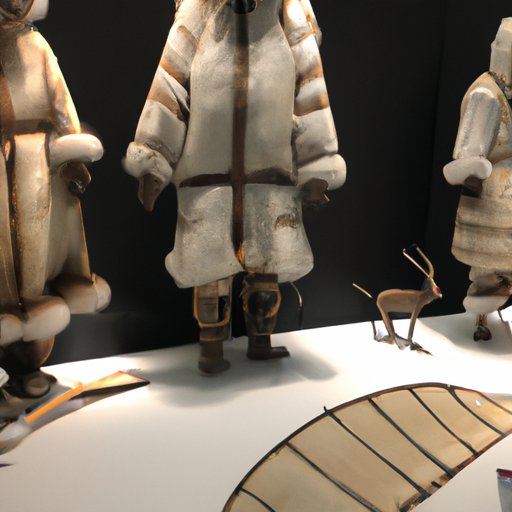Introduction
Inuit culture is an ancient way of life that has been passed down from generation to generation for thousands of years. This unique culture is centered around the Arctic Circle, primarily in Canada, Greenland, and Alaska. Inuit culture is rich with traditions, values, art, music, dance, food, and clothing that are all deeply rooted in their environment and lifestyle.
The purpose of this article is to explore the history, values, and art of the Inuit people and discuss the impact of colonization on their culture. By understanding the history, values and art of Inuit culture, we can gain a better appreciation for this unique culture.

History and Language of Inuit Culture
The Inuit people are believed to have originated from Siberia and migrated over time to the Arctic regions. The first Inuit people arrived in what is now known as Canada around 4,000 years ago. They spread out across the Arctic region, eventually reaching Greenland and Alaska.
The Inuit language is an Eskimo-Aleut language and is spoken by approximately 120,000 people worldwide. There are several dialects of the Inuit language, including Inupiaq, Yupik, Iñupiat, and Greenlandic. Although the language has declined in recent years due to cultural assimilation, there is still a strong effort to preserve the language.

Values and Beliefs of Inuit Culture
Inuit culture is heavily focused on community and family. Respect for elders is highly valued, and children are taught to show respect for their parents and other members of the community. Inuit culture is also deeply rooted in nature, and they have a great respect for the environment and animals.
Shamanism and spirituality also play a major role in Inuit culture. Shamans are thought to be able to communicate with spirits and connect with the spiritual world. Shamanism is still practiced today by some Inuit communities.
Exploring Inuit Art, Music and Dance
Inuit art is highly recognizable and includes sculptures, masks, and prints. Traditional Inuit art often depicts animals such as polar bears, seals, whales, and walruses. These sculptures and masks are made from materials such as caribou antlers, whalebone, and stone.
Traditional Inuit music is primarily vocal and features chanting, drumming, and singing. Instruments used include drums, rattles, and flutes. Inuit songs often tell stories of hunting and fishing or celebrate special occasions.
Dance is an important part of Inuit culture. Traditional dances are performed to celebrate weddings, births, and other special occasions. Dances can be accompanied by drums and singing. Some of the most popular traditional dances include the katajjait and the uaajeerneq.
Traditional Food Sources and Cooking Methods
The Inuit relied heavily on hunting and fishing for their food. Commonly hunted animals included seal, caribou, whale, and walrus. Fishing was also an important source of food, and fish such as char and trout were often caught in nearby rivers and streams.
Food preservation was an important part of Inuit culture. Inuit people would use salt, smoke, or fermentation to preserve food for long periods of time. Preparation techniques included boiling, roasting, and steaming.
Inuit Clothing & Sewing Techniques
Inuit clothing is designed to keep them warm in the cold Arctic climate. Materials used to make clothing include animal skins, fur, and plant fibers. Design elements such as hoods, pockets, and drawstrings are used to help keep the body warm.
Traditional Inuit sewing techniques include applique, embroidery, and patchwork. These techniques are used to create intricate designs and patterns on clothing. The Inuit also use quillwork, a technique where quills are used to create decorative designs.

Impact of Colonization on Inuit Culture
Colonization has had a profound impact on Inuit culture. As Europeans arrived in the Arctic region, they brought with them new technologies, languages, and beliefs. This led to a process of cultural assimilation, where Inuit people adopted many of the customs and beliefs of European settlers.
The Inuit language has been greatly affected by colonization. Many Inuit people have lost their native language and only speak English or French. This has resulted in a loss of cultural identity and a disconnection from traditional values and beliefs.
Colonization has also had a major economic and social impact on Inuit culture. Inuit people have faced poverty, unemployment, and inadequate housing, leading to a decrease in the quality of life for many Inuit people.
Conclusion
Inuit culture is an ancient way of life that has been passed down from generation to generation for thousands of years. This unique culture is centered around the Arctic Circle, primarily in Canada, Greenland, and Alaska. Inuit culture is rich with traditions, values, art, music, dance, food, and clothing that are all deeply rooted in their environment and lifestyle.
The impact of colonization on Inuit culture has been immense, resulting in a loss of language and cultural identity. Despite this, there are still efforts to preserve and revive Inuit culture. It is important that we continue to learn about and appreciate Inuit culture and its unique history and values.
(Note: Is this article not meeting your expectations? Do you have knowledge or insights to share? Unlock new opportunities and expand your reach by joining our authors team. Click Registration to join us and share your expertise with our readers.)
